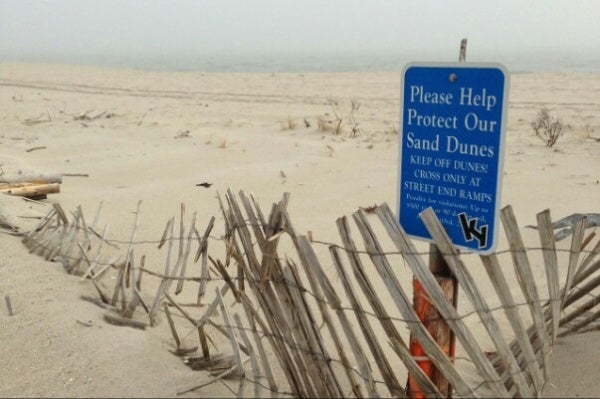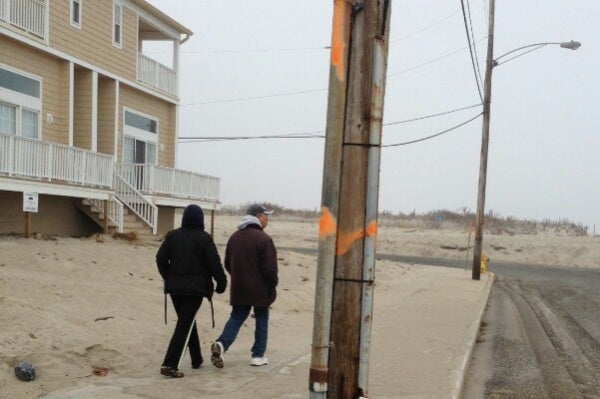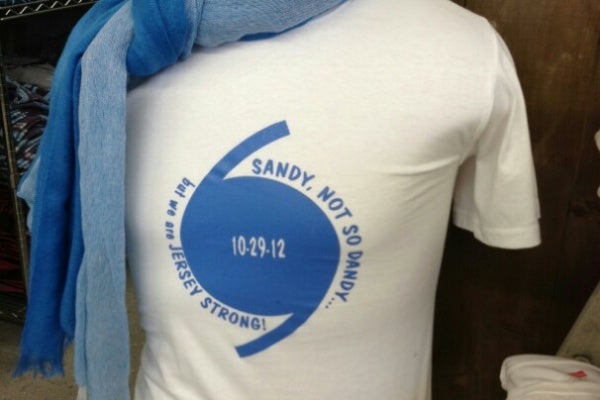After Sandy: Cape May
-

<p><span style="font-family: monospace; font-size: 13.714285850524902px;">Poverty Beach (Jen A. Miller/for NewsWorks)</span></p>
-

<p><span style="font-family: monospace; font-size: 13.714285850524902px;">Across the street from Poverty Beach. The spray paint indicates the height of sand after Sandy. (Jen A. Miller/for NewsWorks)</span></p>
-

<p><span style="font-family: monospace; font-size: 13.714285850524902px;">Tshirt at the Flying Fish Studio, which is replacing its carpet after Sandy flooding (though no merchandise was damaged0</span></p>
The first in a series about how shore towns are faring in the wake of one of the worst storms to ever hit the Jersey Shore.
Cape May looked like it should on a Monday in December: not too crowded, but with enough people strolling Washington Square Mall that the stores are all still open, helping shoppers cross the final items off their holiday lists.
Evidence of Sandy is hard to find here. You must know where to look, like the floor of Flying Fish Studio, which right now is bare concrete instead of carpet. The latter was soaked when the nearby inlet overflowed its boundaries. Higher Grounds Coffee House is closed and “under renovations.” It caught fire during the storm because of salt-water corroded wires.
Highbee Beach, which is a small area along the Delaware side beach of the Cape, lost a chunk of its dunes, and if you drive down to Poverty Beach, at the north end of Cape May proper, you’ll see sand in places it shouldn’t be: on sidewalks, on lawns, overflowing from barriers meant to hold the dunes back. Most of the sand that pushed ashore has been pushed back, but make note of the orange spray paint marks on the telephone polls. They indicate how high the sand was right after the storm, courtesy of Sandy.
Cape May is lucky, as are many towns that are south of where the eye of Sandy made landfall. They were spared a monster, ocean-front storm surge hitting at full moon high tide. If the eye had crossed in Delaware, Cape May would have had a far different fate, especially since, even without the ocean-front storm surge, the Atlantic still breached the sea wall along Beach Avenue, which was built after the Storm of ’62 destroyed the old boardwalk. Also, Cape May’s not a barrier island, so they didn’t suffer the same damage towns barrier island towns to the north did on their bay-sides.
Still, John Cooke, president of the Chamber of Commerce of Cape May and manager of the Victorian Motel, stresses that the full extent of the damage won’t be known for a while yet. “We still don’t know the long term effects,” he said. Cape May typically uses beach tag sales and parking meter revenues to gauge how it’s doing – both inapplicable in the off season. Tax revenues are another sign, though November numbers won’t be in until January.
A walk around town, though, and talking with shop owners suggests that November’s numbers are about 20 percent off what they were last year.
Fortunately, Cooke said, business owners have until July 31 to file economic injury claims with FEMA if, for example, the idea that the Jersey Shore is destroyed persists and crowds don’t come back next summer.
I hardly see that happening here, not when the city’s operating at normal capacity and drawing a crowd on a Monday morning in December.
————–
Jen A. Miller writes the Down the Shore with Jen blog for NewsWorks.org. Jen is author of The Jersey Shore: Atlantic City to Cape May, which is now in its second edition.
WHYY is your source for fact-based, in-depth journalism and information. As a nonprofit organization, we rely on financial support from readers like you. Please give today.

